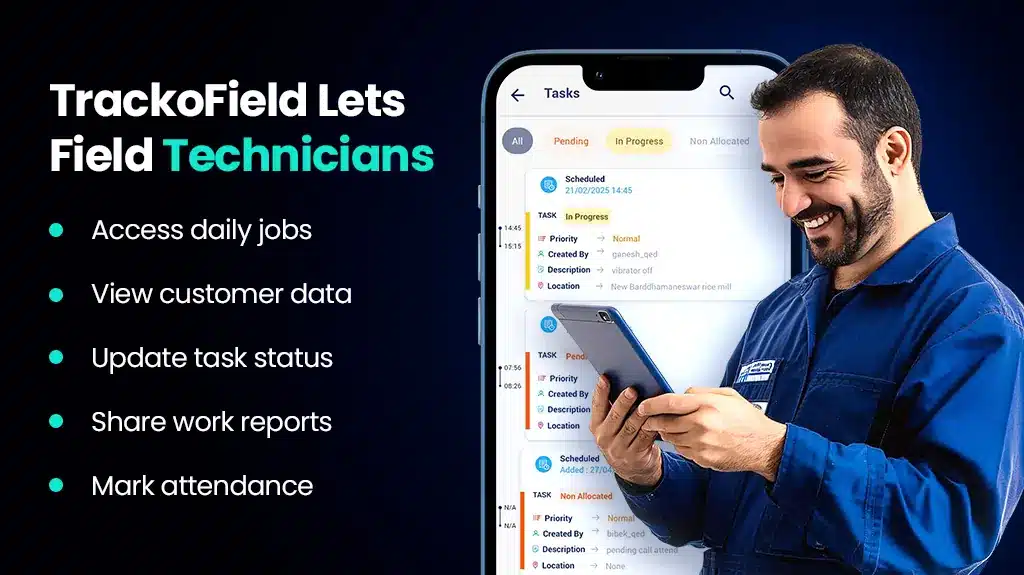-
TrackoBit
Manage commercial vehicles with the new-age Fleet Management Software
TrackoBit -
TrackoField
Streamline your scattered workforce with Field Force Management Software
TrackoField -
Features Resources
-
Blog
Carefully curated articles to update you on industrial trends. -
White Paper
Insightful papers and analysis on essential subject matters. -
Glossary
Explore an alphabetical list of relevant industry terms. -
What’s New
Get TrackoBit & TrackoField monthly updates here. -
Case Study
Explore the cases we solved with our diverse solutions. -
Comparisons
Compare platforms, features, and pricing to find your best fit.
-
About Us
Get to know TrackoBit: our team, ethos, values, and vision. -
Careers
Join the most dynamic cult of coders, creatives and changemakers. -
Tech Support
Learn about our technical support team and services in detail. -
Events
Check out the exhibitions where we left our marks and conquered. -
Contact Us
Connect with us and let us know how we can be of service.
Field Service Management Market Size & Latest Trends for 2025
- Author:Nandita Gupta
- Read Time:6 min
- Published:
- Last Update: May 22, 2025
Table of Contents
Toggle
Discover the top 10 field service management market trends and stats. Know how it will help you embrace more streamlined operations and customer experiences.
Table of Contents
Toggle
Businesses are using the latest digital tools to improve field service operations and customer experiences. Many are adopting AI/ML-powered field service management software (FSM) to work faster and smarter. These tools help automate important tasks like job scheduling, order management, and tracking attendance.
The global FSM market is growing fast! It was worth $5.2 billion in 2021 and is expected to reach $29.9 billion by 2031, growing at 19.2% per year.
Experts share their insights on the future of FSM and how businesses can stay ahead.
Field Service Management Software – Usage Stats
- Employers use FSM software in 48% of cases.
- Cloud-based FSM solutions are leveraged by 51% of fleet management businesses. 52% of businesses integrated this software with their fleet tracking systems.
- The worldwide market of such software will grow at a CAGR of 19.7% between 2021 and 2030. It is expected to reach a value of $24,294,000.00 by 2030.
- For 61% of fleet managers, the FSM software’s ability to automate record gathering and updating is a crucial feature.
Field Service Management Software Technologies Statistics
- Artificial intelligence and mobility help field agents’ efficiency by up to 30% to 40%.
- IoT is a part of almost 73% of field management companies.
- About 75% of field service companies with the use of mobility technologies have witnessed increased employee productivity and customer satisfaction.
- 42% of companies have employed the Internet of Things (IoT) – compiled by According to Mordor Intelligence.
Field Service Management Trends Statistics – What Customers’ Expect?
- 66% of customers want businesses to recognize their requirements and expectations.
- 89% of clients desire on-demand and modern technology for scheduling technicians. Almost as many are ready to pay more.
- 90% of customers say that a service has a great role in determining their decision regarding whether they want to continue business with a certain business or not.

Fun meme describing need for field service management
Top 10 Field Service Management Future Trends 2025 – What’s Next!
Here are the top Field Service Management (FSM) trends for 2025.
1. More Mobile Field Services
Mobile technology is becoming crucial in on-site service operations. Over 49% of the field workforce relies on mobile devices for to and fro communication. Such mobile apps enable on-site technicians to:
- Access daily job details
- View customer information & addresses
- Instantly update task status
- And share work reports from the ask site itself
This is the best way to speed up the accounting process and reduce paperwork and clerical errors. TrackoField App offers real-time task and on-site activity status. This helps in improving issue resolution and delivery of quality services.

TrackoField Offers an All-inclusive Technician app
2. Magnified Real-Time Visibility and Monitoring
Real-time visibility tools are gaining traction across service industries. With real-time FSM systems, companies can monitor on-site operations. And also, tracks technician progress, and optimize field service scheduling.
This helps:
- Improve decision-making
- Ensure that service is provided on time
- Boost customer satisfaction by quickly resolving issues.
💡For example – TrackoField’s cloud-based FSM software continuously monitors on-ground activities. This enables service businesses to respond rapidly to service requests. All leading to higher customer retention and loyalty.
3. AI and Automation Integration will Double
The industry is becoming more automated with AI and machine learning. Routine on-site jobs will be easy to automate routine. On-ground managers can remotely access work orders, and plan job schedules. And can even devise a troubleshooting plan.
Such automation will help reduce manual effort, lower costs, and improve efficiency.
Predictive analytics powered by AI helps plan for the issues and resources needed. There will be more proactive service delivery and operational management. FSM tools will become more intelligent. To a level to streamline operations and help businesses scale faster.
4. Cloud-Based Deployment
Cloud deployment is rapidly replacing on-premises solutions. Because it’s:
- Flexible
- Low in cost
- Offers easy remote access
More cloud-based FSM systems will allow businesses to manage off-site operations and service data efficiently. All while ensuring real-time access from anywhere.
Who will this help?
Companies with remote or distributed teams. Cloud adoption is growing because of its reduced infrastructure costs and improved scalability. This provides greater control over operations and better customer service.
5. More Focus on Customer Experience and Management
Customer management is becoming a top priority for businesses using FSM solutions. Such software is aiding companies in surpassing customer interactions.
Managers can use the software to track service deliveries and regulate service contracts. Customer-centric FSM even allows companies to share agents tracking IDs. This helps them stay assured of their arrival times and expect an on-time response.
6. Industry-Specific Solutions
Different industries are adopting FSM solutions tailored to their specific needs. Manufacturing, healthcare, and energy sectors are looking for custom FSM platforms.
- Manufacturing units need FSM tools to aid in on-site distribution and sales capacity.
- Healthcare platforms need FSM to improve on-site agents’ scheduling, tracking & overall management.
7. Field Technicians’ Safety and Compliance
Field worker safety is becoming a top concern. Hence, many FSM solutions now focus on offering tools that enhance safety protocols. Apart from real-time updates on agents’ activities, FSM has other safety features. Like in TrackoField, you get the SOS feature. On-site agents can trigger this button from their app to notify their managers.
8. Geospatial Tools Integration
Geospatial technologies are more apparent in FSM. The software now has powerful GPS and geo-verified, geofenced additions to it. This helps verify agents’ geo presences with timestamps. It ensures agents are available to tasks locations at the allocated time schedule.
The plus side?
This integration aids in more precise real-time location updates. This makes dispatching easier and improves response times.
9. Scheduling Optimisation
Coordinating and scheduling on-site workers is tough. Service delivery gets disturbed due to:
- Unexpected changes in appointments
- Bad weather conditions
- Or any other unpredictable working conditions disrupt service delivery.
Hence, companies are automating field service scheduling and dispatching to optimise dispatch times.
Many software offers options to review routes & adjust them. This is reducing delays and narrowing service-delivery windows.
10. Blended Workforce – “After Great Resignation”
Field service businesses are now ready to work with seasonal or contract-based field employees.
This need evolved majorly after “The Great Resignation” after the COVID scenario. The event created stress and caused a shortage of labor. In 2025 and beyond, we will see more demand for installations and repair services employing more quality ground technicians.
| 🔍All in All!
FSM trends are rapidly evolving with a focus on efficiency, automation, real-time visibility. And most of all “customer experience”. Service companies that embrace these trends will be golden. They will be better able to optimize operations to cut costs & improve services. |
Final Thoughts
The service industry is evolving rapidly. There are too many rapid technology transformations all at once. In field service management, there is a focus on geospatial tech, AI automation in on-site supervision and so much more. Adopting trends like these will let companies boost their on-site ops. and teams with better approaches.
To stay ahead, businesses must go beyond just keeping up with trends. They need to invest in robust field force management software. The right solution can streamline scheduling, enhance dispatching, and reduce operational costs. All while ensuring long-term success in a competitive market.
Field Service Management Trends FAQs
-
What is Field Service Management?
Field Service Management is a process of organising, managing, and optimising field. It involves managing operations of: - Repairs - Consultations - Sales - Customer support, and even regular inspections.
-
What are the worst FSM Market Challenges?
Delayed service scheduling and arrival is the worst challenge for the field service market.
-
How much is field service management (FSM) market growth by 2032?
The field service management market is expected to reach USD 11.87 billion by 2032.
-
Which is the best field service management software?
TrackoField is one of the best field service management software that helps automate, optimise, and manage on-site service operations and technicians.
Nandita is the Team Lead for Content Marketing at TrackoBit, bringing over a decade of experience in B2B, B2C, and IoT sectors. She has a proven track record of helping Read More
Related Blogs
-

Loan Disbursement in NBFCs: From 15 Days to 3 Minutes – Learn How
Shemanti Ghosh December 11, 2025TrackoField’s AI-enabled field force automation software speeds up loan disbursals in NBFC with field agent task monitoring and facial attendance…
-

AI Facial Recognition Attendance: A Game-Changer for Fraud-Free Field Operations
Mudit Chhikara December 9, 2025Ensure transparent attendance and eliminate fraud before it even starts with AI facial recognition and geofencing.
-

Boost Agri-Input Sales Efficiency with TrackoField’s Sales Order Management Module
Shemanti Ghosh December 3, 2025Grow Agri-input sales and expand farmer database with TrackoField’s Sales Order Management module.
-

Tired of Fake Field Visits in your MFIs? Face AI Attendance Can Help
Mudit Chhikara November 5, 2025How Face AI Attendance can help end fake field visits in MFIs for good.

Subscribe for weekly strategies to boost field team productivity.
Your inbox awaits a welcome email. Stay tuned for the latest blog updates & expert insights.
"While you're here, dive into some more reads or grab quick bites from our social platforms!"Stay Updated on tech, telematics and mobility. Don't miss out on the latest in the industry.
We use cookies to enhance and personalize your browsing experience. By continuing to use our website, you agree to our Privacy Policy.



































